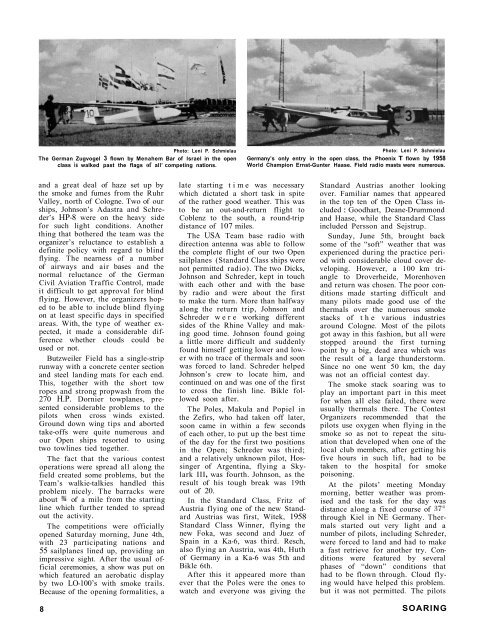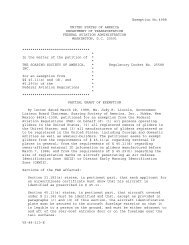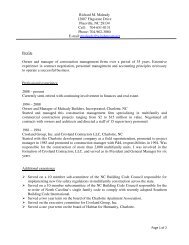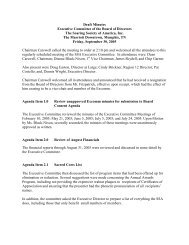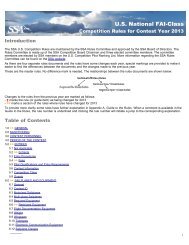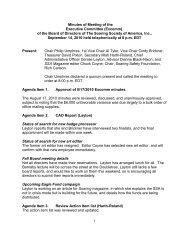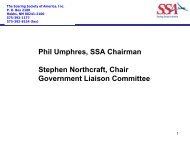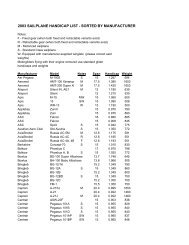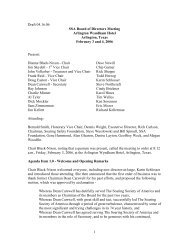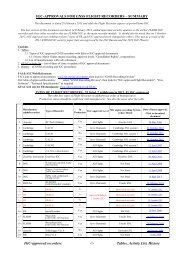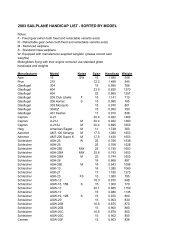1960 World Gliding Championships - Soaring Society of America
1960 World Gliding Championships - Soaring Society of America
1960 World Gliding Championships - Soaring Society of America
Create successful ePaper yourself
Turn your PDF publications into a flip-book with our unique Google optimized e-Paper software.
Photo: Leni P. Schmielau<br />
The German Zugvogel 3 flown by Menahem Bar <strong>of</strong> lsrael in the open<br />
class is walked past the flags <strong>of</strong> all’ competing nations.<br />
and a great deal <strong>of</strong> haze set up by<br />
the smoke and fumes from the Ruhr<br />
Valley, north <strong>of</strong> Cologne. Two <strong>of</strong> our<br />
ships, Johnson’s Adastra and Schreder’s<br />
HP-8 were on the heavy side<br />
for such light conditions. Another<br />
thing that bothered the team was the<br />
organizer’s reluctance to establish a<br />
definite policy with regard to blind<br />
flying. The nearness <strong>of</strong> a number<br />
<strong>of</strong> airways and air bases and the<br />
normal reluctance <strong>of</strong> the German<br />
Civil Aviation Traffic Control, made<br />
it difficult to get approval for blind<br />
flying. However, the organizers hoped<br />
to be able to include blind flying<br />
on at least specific days in specified<br />
areas. With, the type <strong>of</strong> weather expected,<br />
it made a considerable difference<br />
whether clouds could be<br />
used or not.<br />
Butzweiler Field has a single-strip<br />
runway with a concrete center section<br />
and steel landing mats for each end.<br />
This, together with the short tow<br />
ropes and strong propwash from the<br />
270 H.P. Dornier towplanes, presented<br />
considerable problems to the<br />
pilots when cross winds existed.<br />
Ground down wing tips and aborted<br />
take-<strong>of</strong>fs were quite numerous and<br />
our Open ships resorted to using<br />
two towlines tied together.<br />
The fact that the various contest<br />
operations were spread all along the<br />
field created some problems, but the<br />
Team’s walkie-talkies handled this<br />
problem nicely. The barracks were<br />
about <strong>of</strong> a mile from the starting<br />
line which further tended to spread<br />
out the activity.<br />
The competitions were <strong>of</strong>ficially<br />
opened Saturday morning, June 4th,<br />
with 23 participating nations and<br />
55 sailplanes lined up, providing an<br />
impressive sight. After the usual <strong>of</strong>ficial<br />
ceremonies, a show was put on<br />
which featured an aerobatic display<br />
by two LO-100’s with smoke trails.<br />
Because <strong>of</strong> the opening formalities, a<br />
8<br />
late starting t i m e was necessary<br />
which dictated a short task in spite<br />
<strong>of</strong> the rather good weather. This was<br />
to be an out-and-return flight to<br />
Coblenz to the south, a round-trip<br />
distance <strong>of</strong> 107 miles.<br />
The USA Team base radio with<br />
direction antenna was able to follow<br />
the complete flight <strong>of</strong> our two Open<br />
sailplanes (Standard Class ships were<br />
not permitted radio). The two Dicks,<br />
Johnson and Schreder, kept in touch<br />
with each other and with the base<br />
by radio and were about the first<br />
to make the turn. More than halfway<br />
along the return trip, Johnson and<br />
Schreder w e r e working different<br />
sides <strong>of</strong> the Rhine Valley and making<br />
good time. Johnson found going<br />
a little more difficult and suddenly<br />
found himself getting lower and lower<br />
with no trace <strong>of</strong> thermals and soon<br />
was forced to land. Schreder helped<br />
Johnson’s crew to locate him, and<br />
continued on and was one <strong>of</strong> the first<br />
to cross the finish line. Bikle followed<br />
soon after.<br />
The Poles, Makula and Popiel in<br />
the Zefirs, who had taken <strong>of</strong>f later,<br />
soon came in within a few seconds<br />
<strong>of</strong> each other, to put up the best time<br />
<strong>of</strong> the day for the first two positions<br />
in the Open; Schreder was third;<br />
and a relatively unknown pilot, Hossinger<br />
<strong>of</strong> Argentina, flying a Skylark<br />
III, was fourth. Johnson, as the<br />
result <strong>of</strong> his tough break was 19th<br />
out <strong>of</strong> 20.<br />
In the Standard Class, Fritz <strong>of</strong><br />
Austria flying one <strong>of</strong> the new Standard<br />
Austrias was first, Witek, 1958<br />
Standard Class Winner, flying the<br />
new Foka, was second and Juez <strong>of</strong><br />
Spain in a Ka-6, was third. Resch,<br />
also flying an Austria, was 4th, Huth<br />
<strong>of</strong> Germany in a Ka-6 was 5th and<br />
Bikle 6th.<br />
After this it appeared more than<br />
ever that the Poles were the ones to<br />
watch and everyone was giving the<br />
Photo: Leni P. Schmielau<br />
Germany’s only entry in the open class, the Phoenix T flown by 1958<br />
<strong>World</strong> Champion Ernst-Gunter Haase. Field radio masts were numerous.<br />
Standard Austrias another looking<br />
over. Familiar names that appeared<br />
in the top ten <strong>of</strong> the Open Class included:<br />
Goodhart, Deane-Drummond<br />
and Haase, while the Standard Class<br />
included Persson and Sejstrup.<br />
Sunday, June 5th, brought back<br />
some <strong>of</strong> the “s<strong>of</strong>t” weather that was<br />
experienced during the practice period<br />
with considerable cloud cover developing.<br />
However, a 100 km triangle<br />
to Droverheide, Morenhoven<br />
and return was chosen. The poor conditions<br />
made starting difficult and<br />
many pilots made good use <strong>of</strong> the<br />
thermals over the numerous smoke<br />
stacks <strong>of</strong> t h e various industries<br />
around Cologne. Most <strong>of</strong> the pilots<br />
got away in this fashion, but all were<br />
stopped around the first turning<br />
point by a big, dead area which was<br />
the result <strong>of</strong> a large thunderstorm.<br />
Since no one went 50 km, the day<br />
was not an <strong>of</strong>ficial contest day.<br />
The smoke stack soaring was to<br />
play an important part in this meet<br />
for when all else failed, there were<br />
usually thermals there. The Contest<br />
Organizers recommended that the<br />
pilots use oxygen when flying in the<br />
smoke so as not to repeat the situation<br />
that developed when one <strong>of</strong> the<br />
local club members, after getting his<br />
five hours in such lift, had to be<br />
taken to the hospital for smoke<br />
poisoning.<br />
At the pilots’ meeting Monday<br />
morning, better weather was promised<br />
and the task for the day was<br />
distance along a fixed course <strong>of</strong><br />
through Kiel in NE Germany. Thermals<br />
started out very light and a<br />
number <strong>of</strong> pilots, including Schreder,<br />
were forced to land and had to make<br />
a fast retrieve for another try. Conditions<br />
were featured by several<br />
phases <strong>of</strong> “down” conditions that<br />
had to be flown through. Cloud flying<br />
would have helped this problem.<br />
but it was not permitted. The pilots<br />
SOARING


